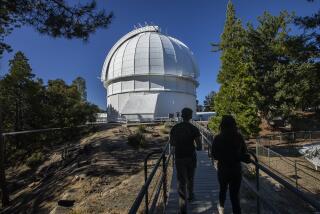Detective Runs Down Interference, Clears the Air for ‘Listening’ to Stars
- Share via
GREEN BANK, W. Va. — Leaking power lines, electric blankets and spark plugs disturb the airwaves above the National Radio Astronomy Observatory until Wesley Sizemore, the radio detective, goes to work.
Sizemore maintains the observatory’s “radio quiet zone” by tracking down interference that hinders astronomers’ efforts to collect electromagnetic signals from distant stars, gas clouds and galaxies.
“You’re very much like a detective,” Sizemore said. “You have to find clues, follow them up and ferret it out.”
One recent tracking job led Sizemore and his truck, equipped with a directional antenna, to the electrified fence that separates the cows from the bull at Jacob and Edith Sheets’ homestead.
The Sheetses were already concerned when he arrived--not about the observatory, but about noise on their kitchen radio.
“It was going zap-zap-zap constantly,” Edith Sheets said. The fence had been damaged by lightning and was emitting signals that interfered with both the observatory’s telescopes and the Sheets’ radio.
Free Electrical Repairs
“Evidently, he’s a pretty good electrician,” Edith Sheets said. Sizemore repaired the fence in no time --and at no charge.
“It’s like calling the TV repairman and not having to pay,” Sizemore said with a smile.
The radio observatory is nestled in a valley surrounded by groves of pine trees that dampen the effects of “radio noise,” but the giant, dish-type receivers still can pick up anything in the area that creates a big enough spark.
“It could be an electric blanket, a light switch, a faulty power line or an auto ignition,” Sizemore said.
Harry Payne, a Green Bank astronomer, is all too familiar with such earthly phenomena. He often peers into his monitor screen, only to find the signal jumping wildly.
Waiting for the right moment to “listen” to a faraway pulsar only to be serenaded by someone’s faulty thermostat is quite a disappointment, Payne said.
“It’s about the worst feeling you can have,” he said.
Sizemore, 32, is a bearded Greenbrier County native who wears his hair in a queue. He is equally at home with the farmers and the astronomers. He can talk astro-tech with the best of them, and sometimes it is necessary--such as when one scientist thought he might be in contact with creatures from outer space.
‘Alien’ Signal Wasn’t
“For some reason, he thought that extraterrestrials could be detected by looking for them on a particular type of frequency,” Sizemore said. “He found a signal that matched exactly what he was looking for. He got all excited.”
Further probing, however, tracked the “alien being” to a glitch in an observatory computer.
“It deflated his balloon,” Sizemore said, “but it wasn’t that much of a letdown. Anybody who takes up a search for extraterrestrials stands a 99% chance of not finding anything.”
Sizemore makes his rounds in a diesel truck, one of a fleet of non-interfering vehicles maintained by the observatory. But some sources of interference are harder to reach than the neighbors’ faulty electric blankets and light switches.
One such culprit is the Soviet satellite GLONASS, which transmits on a frequency that is of interest to radio astronomers. The satellite recently ruined reception of data on the makeup of the gas cloud Cassiopeia-A.
International Dispute
“Right now, it’s in the hands of the National Science Foundation, and they’re holding discussions with the Russians to see what can be done,” Sizemore said.
The U.S. government also causes radio interference. The National Emergency Air Command Post, a plane that acts as a constant “White House in the sky,” sometimes flies over the observatory. Communications with ground personnel create a familiar scribble on astronomers’ data sheets.
Sizemore said he’s had some success at persuading NECAP to keep the noise down, but federal officials retain the right to take the plane anywhere they choose.
“At that point, the astronomers have to tolerate it,” he said.
Other forms of interference come and go, like automobiles on the highway.
“An old car that’s missing on every other plug comes over the hill. We’ll get interference for 30 seconds, and never see him again.”
While some sources never can be pinned down, others just take a little extra effort. Sizemore remembers a phantom signal that came in irregular bursts about every 15 minutes.
School Heater on Blink
He followed it to an elementary school, then lost it again. He sat in his truck, waiting for the radio bandit to return.
He waited. Then he waited some more.
Nothing.
“Sometimes, no matter how good a detective you are, you can’t find out who’s making the noise,” he said.
Eventually, however, Sizemore traced that mystery signal to a faulty heater.
“The room would cool down and the heater would go on, then go off, wait 15 minutes and go on again,” he said. “We removed the heater, took it to the lab, repaired it and took it back, and there was no trouble after that.”
Sizemore said word of his free repair work has gotten around town. He has fielded a few calls from people who ardently hoped that their broken appliances were causing trouble for the astronomers.
More to Read
Sign up for Essential California
The most important California stories and recommendations in your inbox every morning.
You may occasionally receive promotional content from the Los Angeles Times.













